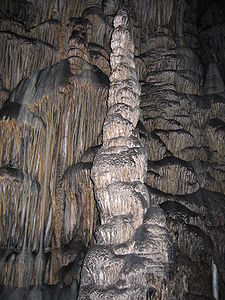- Psychro Cave
-
Psychro Cave is an ancient Minoan sacred cave in the Lasithi district of eastern Crete. Psychro is associated with the Diktaean Cave, the putative site of Zeus' birth. According to Hesiod, Theogony 477, Rhea gave birth to Zeus in a cave of Mount Aegaeon, near Lyttos; since the late nineteenth century the cave above the modern village of Psychro has been identified with this sanctuary.
Contents
Geography
Psychro is 1,025 meters above sea level. The cave is located in the prefecture of Lasithi.
Myth
The Dictaean cave is famous in Greek mythology as the place where Amalthea, perhaps known in Crete as Dikte, nurtured the infant Zeus with her goat's milk, the mythic connection to the long use as a site of cult attested here by archaeology. The nurse of Zeus, who was charged by Rhea to raise the infant Zeus in secret here, to protect him from his father Cronus (Krónos) is also called the nymph Adrasteia in some contexts.[1]
Archaeology
The cave was first excavated in 1886 by Joseph Hatzidakis, President of the Syllogos at Candia, and F. Halbherr.[2] In 1896, Sir Arthur Evans investigated the site.[3] In 1899, J. Demargne and David George Hogarth of the British School at Athens conducted further investigations; Hogarth's brief report published in 1900[4] gives a picture of the destruction wrought by primitive archaeological methods: immense fallen blocks from the upper cave roof were blasted before removal; the rich black earth had been previously ransacked. The stuccoed altar in the upper cave was discovered in 1900, surrounded by strata of ashes, pottery and "other refuse", among which were votive objects in bronze, terracotta, iron and bone, with fragments of some thirty libation tables and countless ceramic conical cups for food offerings. Bones among the ash layer attest to sacrifice of bulls, sheep and goats, deer and a boar.[5] The undisturbed lowest strata of the upper cave represented the transition between Late Minoan Kamares ware to earliest Mycenaean levels; finds represented the Geometric Style of the ninth century BCE, but few later than that. More recent excavation has revealed the use of the cave reached back to Early Minoan times, and votive objects attest to the cave's being the most frequented shrine by Middle Minoan times (MM IIIA).[6]
The lower grotto falls steeply with traces of a rock-cut stair to a pool, out of which stalactites rise. "Much earth had been thrown down by diggers of the Upper Grotto," Hogarth reported, "and this was found full of small bronze objects." In the vertical chinks of the lowest stalactites, Hogarth's team found "toy double-axes, knife-blades, needles, and other objects in bronze, placed there by dedicators, as in niches. The mud also at the edge of the subterranean pool was rich in similar things, and in statuettes of two types, male and female and engraved gems."
In 1961, John Boardman published the finds uncovered by these and other, illegal, excavations.
While clay human figurines are normally found in peak sanctuaries, Psychro and the sanctuary on Mount Ida stand out as the only sacred caves that have yielded human figurines. Psychro is also a unique sacred cave for a bronze leg, also known as a votive body part, which is the only votive body part to be found in a sacred cave. More common sacred cave finds at Psychro include stone and ceramic lamps.
Psychro yielded an uncommon number of semi-precious stones, including carnelian, steatite, amethyst, jasper and hematite.
Psychro's artefacts are now on display at the Heraklion Museum and the Ashmolean Museum, Oxford.
Notes
- ^ Bibliotheke, 1.1.6.
- ^ F. Halbherr and P. Orsi, "Scoperte nell' Antro di Psychro", Museo dell' Antichità Classico 2 1888 pp. 905-10.
- ^ Evans, "Further discoveries of Cretan and Aegean scripts," JHS 17 (1897), pp 305-57.
- ^ D. G. Hogarth, "The Cave of Psychro in Crete" The Journal of the Anthropological Institute of Great Britain and Ireland 30 (1900), pp. 90-91.
- ^ W. Boyd-Dawkins, "Remains of Animals Found in the Dictaean Cave in 1901," Man 32 (1902) Royal Anthropological Institute of Great Britain and Ireland, pp. 162-65.
- ^ L. Vance Watrous and H. Blitzer, "Lasithi: A History of Settlement on a Highland Plain in Crete" Hesperia Supplements 18 (1982), pp. i-xiv,1-122.
References
- Jones, Donald W. 1999 Peak Sanctuaries and Sacred Caves in Minoan Crete ISBN 91-7081-153-9
- Rutkowski, B. and Krzysztof Nowicki, 1996. The Psychro Cave and Other Sacred Grottoes in Crete (Warsaw: polish Academy of Science).
- Watrous, L. Vance 1996. The Cave Sanctuary of Zeus at Psychro: A Study of Extra-Urban Sanctuaries in Minoan and Early Iron Age Crete (Liège/Austin:Université de Liège/University of Texas at Austin)
External links
Coordinates: 35°09′46″N 25°26′42″E / 35.1628055°N 25.4448972°E
Categories:- Archaeological sites in Crete
- Minoan civilization
- Lasithi
- Greek mythology
- Caves of Greece
- Minoan archaeological sites in Greece
- Ancient caves of Greece
Wikimedia Foundation. 2010.

